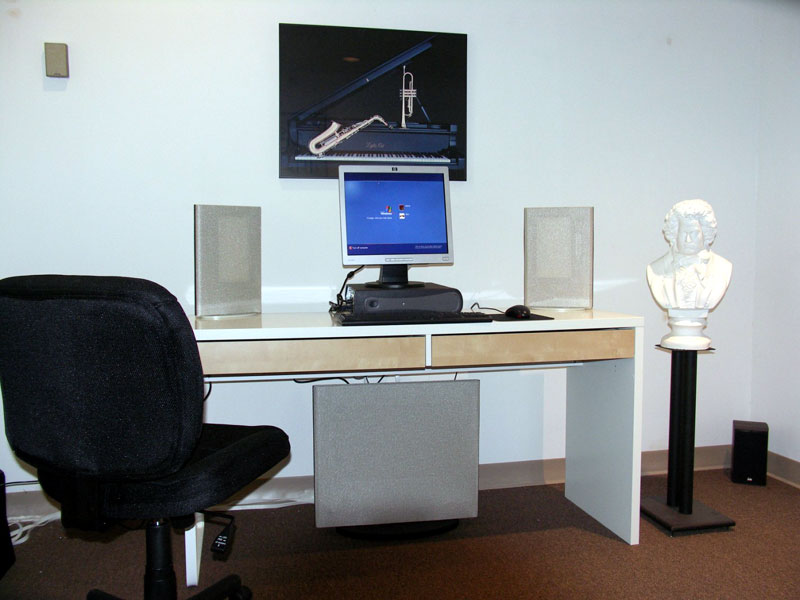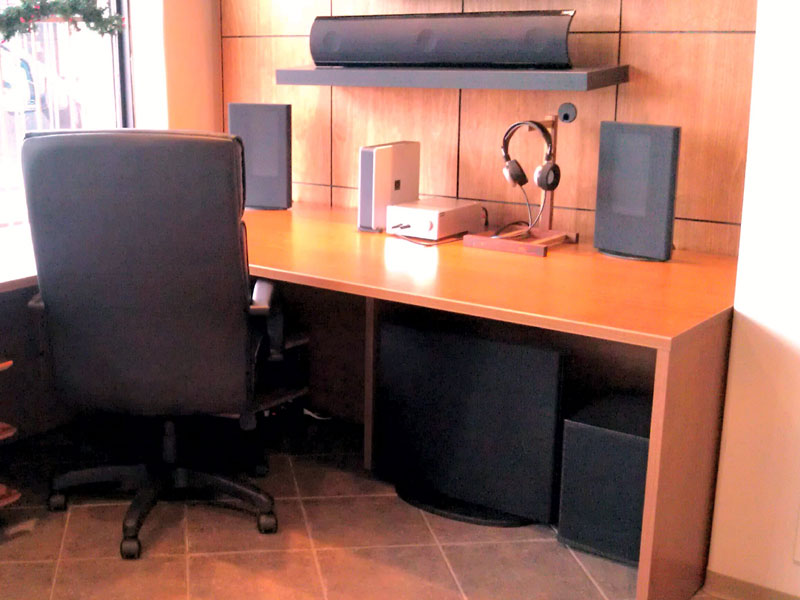We Didn't Know How Good We Had It: Thoughts on Maggie Dealer-Direct and the Mini Maggie System
often think about how the sale of audio equipment has changed since the mid-1980s, when I was taking my first lurching steps into the mysterious world of audiophilia. I grew up in Madison, Wisconsin, a college town with a healthy lineup of audio stores. Playback was in the mall and sold mostly mass-market electronics and speakers, although its darkened back demo room was as exotic to me as Jamaican rum in the land of cheap beer. When I was still in my teens, I bought a seriously pounding pair of speakers there. I don't remember anything about the brand other than that it was not one anyone would easily remember, but I do vividly recall the 15" woofers that impressed everyone who saw them. The next step up the quality ladder was The Happy Medium on State Street, about halfway between the state capitol and Bascom Hill, the heart of the University of Wisconsin's campus. The rack of pricey (by the standards of those days) Sheffield Labs and Telarc LPs near the front door signaled that this was more of an audiophile-oriented shop than Playback, and it had the products to match. I bought the speakers that replaced my 15-inchers here -- Polk Audio RTA-12Bs, the ones with the crossover mounted on top for all to see. After I bought my first CD player (a Sony CDP-101) in 1983, I also bought CDs here -- at something over $20 each. The epitome of audio extremism, at least in Madison, was Audiophile's Sound Studio, a cramped shop in another, much smaller mall. I distinctly remember the Keith Monk's record cleaner near the front counter; you could have your records cleaned with it and resleeved for $1 each. It was here that I first saw Mark Levinson electronics, along with a plethora of speakers covered in the audio press, all of which was considered underground in those days. The salespeople were stereotypically elitist; just mentioning that I owned Polk speakers would have drawn disapproving chuckles. I loved this shop for all of these things, along with its clutter and smell -- the combination of dust burning off tubes and newly opened records. While these were the audio shops I remember most vividly, there were others in Madison as well. And in those days, I could buy records at any department store, although Discount Den on campus, a catchall grocery-and-drug store, had the best prices and would gladly exchange bad pressings. Fast-forward to today and, of course, things are very different. Playback, The Happy Medium and Audiophile's are all long gone. There are still a couple of stores in Madison, but they are more electronics shops than audio shops -- selling more accessories for flat-screen TVs than phono cartridges, by a mile. I miss the days of easy-to-find audio shops and plentiful record stores, and I miss them all the more as both stagger toward complete extinction. Being an audio dealer today means accepting levels of anxiety that were unheard of in the mid-1980s, when audio stores could sell enough product to pay rent in shopping malls. Like so many 20-somethings who can't find work, audio shops have gone back to live at home -- the homes of their owners. It's practical for a dealer to combine his living and working spaces, even if it cramps both family and working life. But even this -- a temporary Band-Aid on what surely looks like a mortal wound -- can't be sustained if its underlying causes aren't addressed. And, as there are fewer dealers, it becomes more difficult for manufacturers to display and thereby sell their products, the disease moving ever closer to the heart of the audio industry. I've already written about Magnepan's response to this complex problem -- a program called Maggie Dealer-Direct. The idea's simplicity makes it appealing, especially for those of us who romanticize the brick-and-mortar-dealer model. Certain models of Magnepan speakers are sold through dealers with a 30-day money-back guarantee. Magnepan drop ships the speakers from its factory to buyers and refurbishes any returned speakers. Dealers continue to be the sales point for the customer by offering their expertise and support, and they take care of the financial part of the transaction. Dealers no longer need to stock every Magnepan model, however, which cuts their overhead. Customers who have no local dealer can still buy Magnepan speakers from an authorized dealer, who gets a sale from someone who won't or can't visit his store. The dealer makes money, Magnepan makes money, and the buyer gets to use his purchase with the security of knowing that he can return it if it doesn't meet his expectations. Win, win and win, in other words.
Conveniently, Magnepan happens to have the perfect product to launch such a buy-then-try program. The Mini Maggie system ($1490, including a single DWM woofer) is just what its name implies: a truly miniature version (about the size and thickness of a chemistry textbook) of a full-sized Magnepan speaker like the 3.7, down to the use of Magnepan's in-house-constructed ribbon tweeter. While the Mini Maggies can be used on stands (which is how I listened to them), they were developed for the desktop as part of a nearfield computer-based audio system. A planar-magnetic panel the size of that used for the Mini Maggie isn't going to move much air, so Magnepan includes one of its DWM woofers, whose larger panels definitely do enhance the Minis' bottom end and extend the qualities of the speakers down to 40Hz. The DWM is essentially a smaller version of the woofer section of Magnepan's 20.1, and it has the crossover for the Mini Maggie built in. The implied promise of the Mini Maggie system -- that it will sound like its larger relatives -- comes to fruition from the first note onward. This is a serious speaker system, not one compromised because it has been tailored for desktop use. It has the overall tonal balance and, more important, treble qualities of the 3.7s, at least based on my hearing of those speakers in Magnepan's listening room, but it can be used in spaces like my smallish office, where 3.7s could never fit. I actually didn't put the Mini Maggies on my desktop; I put them on stands and the DWM wherever I could floorspace. Even so, there was a quick-paced, sprightly quality to the system's sound, along with spatial qualities that belied the Mini Maggies' small size. A single DWM was tricky to position to achieve even channel-to-channel balance, especially in my somewhat cramped office, but a second DWM ($795) solved the problem and brought to the low end a sense of the ambient space that the finest subwoofers achieve. I used a Sonance 260 amp to drive the system. This is a well-made solid-state amplifier from the 1990s, and its 60Wpc were plenty for the Mini Maggies and DWMs, at least in my small office. I also set up the system in my large listening room and drove it with Lamm M1.2 Reference monoblocks. Here, the system had problems filling out the space. Output levels weren't the issue; instead, the Mini Maggies just couldn't conjure a soundscape that was nearly as convincing as that of the many floorstanding speakers I've heard here. While this could have been due to my own deeply rooted perceptions of the sound in my room, I think it was rather a matter of a speaker system meant for a modest space (at best) being out of its element. Magnepan contends that it's primarily a question of power response, reiterating the fact that line-source speakers are tall for a reason. Still, as an alternative to a traditional subwoofer-satellite system, the Mini Maggie system does go where no other full-sized Magnepan system can, and there's also its desktop use, where, I suspect, you will be hard-pressed to find a more complete, more refined speaker system available today. The Mini Maggie system's use as the poster speaker for Maggie Dealer-Direct seems especially shrewd, as it's difficult to determine if this system will meet buyer expectations outside the environment in which it will be used. Even so, some Magnepan dealers are trying, devoting floorspace to computer-based listening stations that feature the Mini Maggie system.
The personal-listening station at Audio Ark in Edmonton, Alberta, Canada. The larger question for Magnepan dealers, however, may be if customers will be able to buy the speakers that are the company's backbone within the hardcore-audiophile segment of its market -- 1.7s, 3.7s and 20.7s – as part of Maggie Dealer-Direct. "Some of them [dealers] asked when, and if, we would include the 1.7s," Wendell Diller of Magnepan told me. It's easy to understand their fervor; the 1.7 is one of Magnepan's best-selling speakers, and even more will leave the factory if they are available through Dealer-Direct. "Okay, good for Magnepan," Wendell concedes.
"But what does that do for high-end audio?" A good question that thankfully has
the viability of the good old days at its heart. I remember my first demo of Magnepan
speakers -- at a store in Northern Virginia whose name I've forgotten but whose decor and
smell are burned into my memory. If Maggie Dealer-Direct can preserve all of that, all
power to it. |


